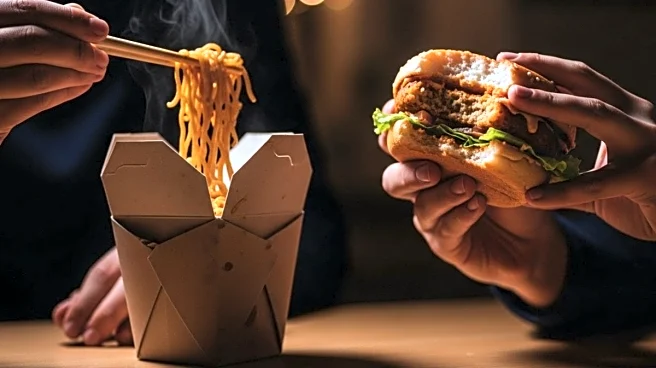India is now the world’s fastest-growing market for ultra-processed foods, with sales surging from a modest ₹8,000 crore in 2006 to an astonishing ₹3.3 lakh crore in 2019, and still accelerating. Packaged
snacks, instant noodles, sugary drinks and ready-to-eat meals have quietly become staples in urban pantries and rural kirana stores alike, often displacing the dal, roti and sabzi that sustained generations.
This is not a uniquely Indian story. On Wednesday, a landmark three-paper series in The Lancet delivered a global alarm: the explosive rise of ultra-processed foods (UPFs) engineered products loaded with sugar, salt, unhealthy fats and laboratory additives, now represents one of the greatest threats to human health in the 21st century. The authors, drawing on evidence from 90 countries, called for urgent policy action: marketing restrictions, front-of-pack warning labels and taxes on the most harmful categories, measures already proving effective in Chile, Mexico and Colombia.
What makes the warning especially chilling is the body count. In the United States, a separate analysis published this year calculated that ultra-processed foods may be causing more premature deaths than opioids, tobacco or guns. In Brazil and Mexico, researchers have linked one in ten deaths among adults aged 30–69 directly to these products. India, with its younger population, thinner average body weight and genetic predisposition to metabolic disease, is particularly vulnerable.
The consequences are no longer theoretical. Cardiologists in Mumbai and Bengaluru report heart attacks in men and women in their thirties that were once rare before fifty. Endocrinologists see Type 2 diabetes diagnosed in teenagers. And in small towns and big cities alike, the evening ritual of home-cooked meals is giving way to neon-lit packets that promise speed, taste and shelf-life while silently shortening lives.
How Rapidly is India’s Diet Shifting Towards Ultra-Processed Foods?
Ultra-processed foods aren’t mere convenience; they’re biochemical saboteurs, designed for palatability over sustenance. Loaded with emulsifiers that disrupt gut microbiomes, artificial sweeteners that confound insulin signals, and trans fats that inflame arteries, they accelerate the NCD triad- diabetes, cardiovascular disease, and obesity, that’s rewriting Indian longevity.
A landmark 30-year Harvard cohort, tracking nearly 115,000 adults, found those in the highest UPF quartile faced a 4% bump in all-cause mortality per 10% caloric increase, with ready-to-eat meats and sugary drinks spiking risks by 13-61%. Translate that to India: The Indian Council of Medical Research (ICMR) attributes 56.4% of the nation’s disease burden measured in lost productivity, hospital bills, and grief to diets skewed by these interlopers, with ultra-processed culprits fueling 80% of preventable Type 2 diabetes cases.
In a country where non-communicable diseases (NCDs) already claim 63% of all deaths, the real gut punch is in the demographics: 25-26% of these fatalities strike between ages 30 and 70, what the World Health Organization deems “premature mortality.” For the under-50 cohort, the drivers are starkly modern: a 40-fold surge in UPF sales from 2006 to 2019, now comprising up to 30% of urban calories, displacing dal-chawal suppers with shrink-wrapped seductions. This isn’t hyperbole; a 2023 modeling study across eight countries, including India analogs like Brazil and Mexico, pegged UPFs to 10% of premature deaths in that 30-69 window, tens of thousands of lives cut short annually, often before grandchildren are born.
How Is Ultra-Processed Food Killing People in Their 30s And 40s?
Globally, UPFs hike cardiovascular death risk by 50%, Type 2 diabetes by 40%, and obesity by 55%, per a 2024 BMJ meta-analysis of 9.9 million souls. In India, where the “thin-fat” phenotype amplifies metabolic havoc, South Asians accrue visceral fat at lower BMIs, the fallout hits the 30s like a monsoon. Diabetes prevalence has quadrupled since 1990, afflicting 101 million, with 15.3% of adults prediabetic; fully half of cases emerge before 40, often in desk-bound millennials whose breakfast is a cereal bar and lunch a microwave biryani.
Heart disease follows suit: Coronary events in under-40s have doubled in urban centers like Mumbai and Bengaluru, linked directly to the sodium-sugar cocktail in UPFs that stiffens vessels and spikes triglycerides. A Lancet series, fresh as November’s chill, spotlights an 18-year-old in Uttar Pradesh—obese, diabetic, borderline hyperlipidemic not from rare genetic curses, but from a diet 70% UPF: chips, colas, and “fortified” juices that leach nutrients while breeding inflammation.
UPFs erode dietary diversity, ICMR’s ICMR-INDIAB survey shows high-carb, low-protein patterns (instant noodles) jacking cardiometabolic odds by 14-30%, while marketing blitzes target the young. Sales to under-30s dominate, with ads on Instagram and school canteens peddling “fun” over fiber, turning adolescence into a preload for 40s infirmity. The economic toll? By 2030, NCDs could siphon 4% of GDP, but the human ledger, death in their 30s, orphaned careers is incalculable.
What Exactly Are Ultra-Processed Foods?
Ultra-processed foods are not simply packaged items. They are industrial products built from modified ingredients, stabilisers, emulsifiers, sweeteners and additives designed to enhance taste, shelf life and appeal. They are engineered to be cheap, filling and instantly gratifying.
The problem lies in what they replace. With every packet of ready-to-eat noodles or sugary drink, people crowd out whole grains, fresh produce, pulses and home-cooked dishes. These foods are high in calories but low in nutrients, making it far easier to consume more energy than the body needs while missing out on fibre, proteins and micronutrients that protect long-term health.
Ultra-processed foods shape the metabolism in ways researchers are only beginning to map. They influence inflammation, alter gut bacteria and make insulin resistance more likely to occur earlier in life. The damage builds quietly until it becomes visible.
Why Is The Youth Population At Maximum Risk?
Young professionals in cities, pressed for time and constantly exhausted, lean heavily on packaged meals and caffeinated drinks. Students rely on instant noodles, biscuits and energy drinks to get through long study hours. Delivery workers and drivers pick up quick snacks because their schedules leave little space for proper meals.
In lower-income communities, affordability plays a role. A large packet of fried snacks often costs less than a bowl of lentils or two pieces of fruit. Families trying to stretch their food budget often choose what fills stomachs quickly, not what nourishes.
India also faces a genetic predisposition to metabolic disease. Many Indians develop visceral fat earlier, even at lower body weights, making them more susceptible to diabetes and heart disease when exposed to calorie-dense, nutrient-poor foods.
Put together, these factors mean that the generation now in its teens, twenties and thirties may experience more aggressive and earlier disease than their parents or grandparents.
Is There No Regulation To Curb Consumption Of Ultra-Processed Foods In India?
India has frameworks and guidelines, but almost nothing with real teeth. As the Lancet series and Indian researchers have repeatedly pointed out, the country is fighting one of the fastest UPF invasions on the planet with 1990s-era tools. Until bold, mandatory measures– black warning labels, marketing bans, and fiscal disincentives are enacted and enforced, regulation will remain more theatre than protection. Here’s the reality as of November 2025:
Front-of-Pack Warning Labels (FoPL)
After years of delay and intense industry lobbying, FSSAI finally notified mandatory star-rating labels in 2024. However, the implementation has been repeatedly postponed; the latest deadline is mid-2026 with the system being widely criticised as too lenient (many high-sugar, high-salt products still get 3–4 stars). Unlike Chile, Mexico or Colombia, India does not use bold black octagon “HIGH IN SUGAR/SALT/FAT” warnings that have been proven to change consumer behaviour.
Marketing to children
There is no statutory ban on junk-food advertising aimed at children. FSSAI’s 2022 draft regulations on restricting marketing in and around schools and on TV before 9 p.m. were watered down after industry pushback and remain unenforced. Celebrity endorsements, cartoon characters, free toys, and school sponsorships by cola and snack brands continue legally and aggressively.
Advertising claims
Companies can still label products “healthy”, “natural”, “wholesome” or “made with real fruit” even when they are 70–80% sugar or refined starch. There is no legal requirement to disclose the degree of processing or the presence of additives like emulsifiers and artificial sweeteners.
Taxes
Unlike Mexico (10% tax on sugary drinks) or the UK (soft-drinks industry levy), India has no specific excise or sin tax on ultra-processed foods or beverages. The highest GST slab these products attract is 18%, the same as fresh fruit or paneer.
School sales
FSSAI’s 2020 guidelines banning the sale of “foods high in fat, salt and sugar” (HFSS) in school canteens and within 50 metres remain largely on paper. Audits by public-health groups show chips, colas and instant noodles are still sold openly in most government and private school campuses.
The Eat Right India movement, industry “pledges” to reduce salt/sugar, and the Food Safety and Standards (Labelling and Display) Regulations all rely heavily on self-regulation by the same companies that profit from addiction-forming formulations.
What Can Individuals Do To Consume Less Ultra-Processed Foods?
There is no denying that the environment is stacked against people trying to eat well. Packaged foods are quick, cheap and everywhere, while fresh, wholesome meals require time, planning and access.
Small shifts matter like replacing daily packaged snacks with fruit or nuts, cooking one more home meal each day, cutting down sugary drinks, choosing whole grains over instant mixes and reading ingredient labels to identify hidden sugars and additives.
Collective awareness helps especially when families, schools and workplaces begin to treat ultra-processed foods as occasional rather than everyday options, social norms shift.
Still, the responsibility cannot rest solely on individuals because in a nation of ancient Ayurvedic wisdom—where food was once medicine, this UPF insurgency feels like sacrilege. The food environment must become healthier for citizens to make better choices.








/images/ppid_59c68470-image-176387003614167599.webp)




/images/ppid_a911dc6a-image-176389924756635120.webp)
